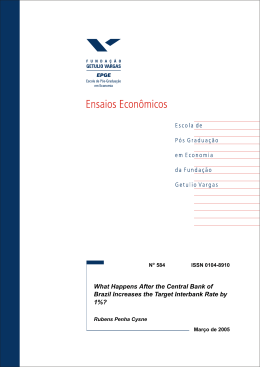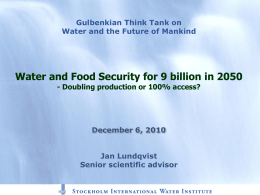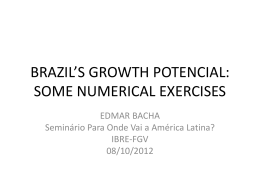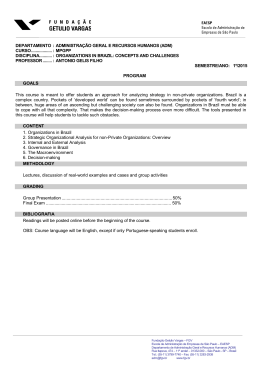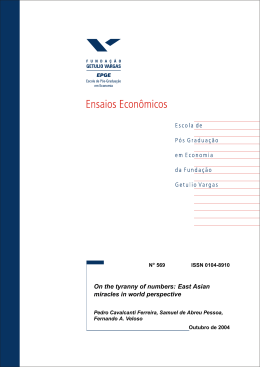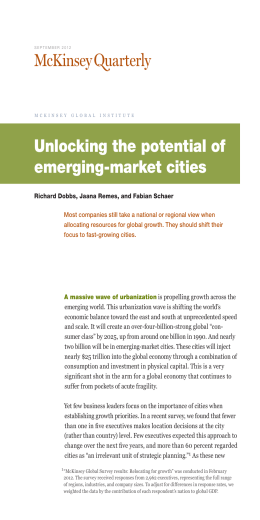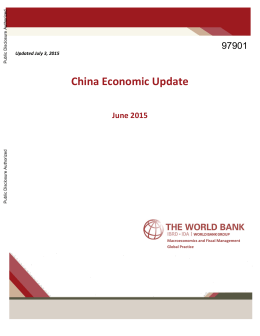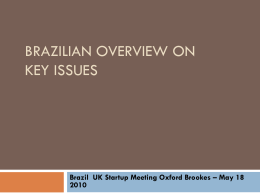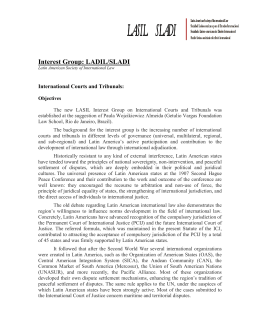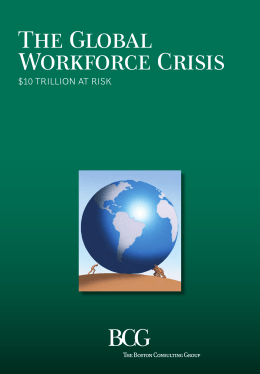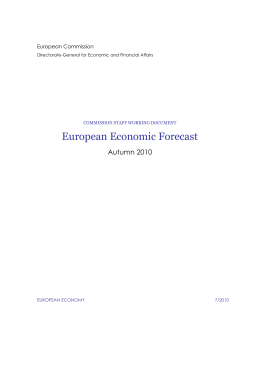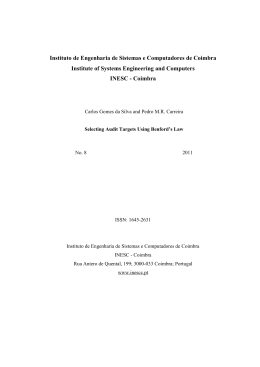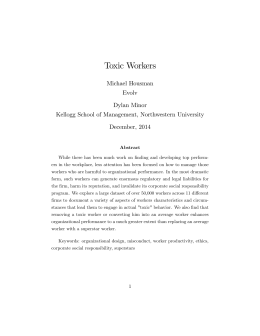No 613 ISSN 0104-8910 On the Economic and Fiscal Effects of Infrastructure Investment in Brazil Pedro Cavalcanti Ferreira, Carlos Hamilton Vasconcelos Araújo Março de 2006 Os artigos publicados são de inteira responsabilidade de seus autores. As opiniões neles emitidas não exprimem, necessariamente, o ponto de vista da Fundação Getulio Vargas. On the Economic and Fiscal E¤ects of Infrastructure Investment in Brazil Pedro Cavalcanti Ferreira Graduate School of Economics - EPGE Fundação Getulio Vargas Carlos Hamilton Vasconcelos Araújo Fundação Getulio Vargas Abstract This article studies the productive impact of infrastructure investment in Brazil. Public-capital expenditures in the country have decreased continuously over the last two decades, and this paper shows the signi…cant impact this has had on infrastructure stocks. Cointegration analysis is used to investigate the long-run association between output and infrastructure, the results being then used to study the short-run dynamic of these variables. Whether in the short or long run, the productive impact of infrastructure was found to be relevant. Other group of simulations studies the impact of expanding capital expenditures through debt …nance on debt to GDP ratio as well as on public cash ‡ow and net worth. This article is part of the WorldBank project on “Managing Fiscal Space”. The authors would like to thank the comments of Luis Serven. 1 1 Introduction Public investment in Brazil, as a share of gross domestic product (GDP), has been falling for the last twenty …ve years. While in the 1969-1984 period, gross capital formation of the central government alone averaged 4.03%, in the following sixteen years it was only 1.85%. In the last few years it has remained at around 0.9% of the GDP, while the gross investment of total government is only 2.2% of output. Moreover, although timing vary, the cuts in infrastructure expenditure a¤ected virtually all sectors. For instance, direct investment in roads from 1990 to 1995 was only, in real terms, one …fth of those made in the 1970-1975 period (Ferreira and Maliagros (1998)), while total public investment in the transportation sector today is less than 0.1% of GDP, an insigni…cant …gure when compared to almost 1.8% in the peak year of 1979. Similar …gures, if somewhat less dramatic, apply to the energy sector, ports, etc. As a consequence, there is a general decrease in the quality of infrastructure services and a relative scarcity of quantities supplied. With respect to the former, although not many numbers are available, casual evidence is abundant. The blackouts and rationing of energy two years ago are believed to have been caused by the reduction in investment in the energy sector. Generating capacity, which grew at an average rate of 10% from 1960 to 1980, increased on average only 3% per year in the following twenty years. World Bank …gures show that the total length of paved roads in the country has stagnated, if not decreased, during the last decade. At the same time, Velloso (2004) shows that in 2003 only 17% of roads in the country were considered in good or very good condition, while 42% were in poor or extremely poor condition. The reduction of capital expenditures is a general phenomenon in Latin America (Calderon, Easterly and Serven (2002)) and is associated with the numerous economic crises the region experienced since Mexico’s default in 1982. These were particularly acute in Brazil, as re‡ected, for instance, by hyperin‡ation, …scal crisis, the suspension of external debt payments, insolvent state and local governments, increasing poverty, etc. As stated by many (e.g., Roubini and Sachs(1989), Calderon, Easterly and Serven (2002) and Mintz and Smart(2004)), in times of …scal restrictions, public investments tend to be overly reduced and the burden of …scal adjustment is felt …rst and with more intensity in infrastructure sectors. This is somehow an expected, if myopic, outcome of the political process. If current and capital expenditures are weighted the same in the government budget, policy makers with short-term tenures (e.g., four or six years) have 2 little incentive to consider the future gains of infrastructure expenditures. This is so because, while most of the expenses are incurred under their own term, most of the bene…ts will be enjoyed after they leave o¢ ce. Even if the net present value of the project is positive, its initial cash ‡ow is always negative and this is critical for any political decision. In an environment with high political instability such as Latin America, this problem tends to be ampli…ed. In the Brazilian case, aside from …scal problems and widespread economic crisis, public budget has become increasingly rigid in the recent past, with mandatory expenditures in education and health, for instance, and mounting expenses in payroll, social security, various social programs and interest1 . Moreover, current agreement with the IMF assumes …scal targets - a 4.25% primary surplus in the current year - which, as usual, make no di¤erentiation between current and capital expenditures. When adding up these factors, one should not be surprised by the reduction of public investment in general, and infrastructure-capital expenditures in particular, observed in Brazil. This article analyzes the economic impact of the recent evolution of infrastructure investment in this country. It is divided in six sections in addition to this introduction. The next two sections present the relevant stylized facts and estimate the relationship between investment ‡ows and the variation of infrastructure stocks. As far as we know, this is the …rst time that this has been done in Brazil, since people generally assume a one-to-one relationship between investment and capital growth. The fourth section estimates the growth impact of public capital and of di¤erent measures of infrastructure stock. This was found to be relevant by a large number of studies ((e.g. Aschauer (1989), Ai and Cassou (1995), Canning and Bennathan (2002), and Easterly and Rebelo (1993)) that used di¤erent types of data and econometric methodology. We initially employ cointegration analysis to investigate the long-run association between output and infrastructure, extending in many directions the analysis presented in Ferreira and Maliagros (1998). These results are then used to study the short-run dynamic of GDP and per capita GDP after shocks to public capital and infrastructure. Both in the short or long run, the productive impact of the di¤erent measures of infrastructure were found to be relevant although not too large. Section Six presents a very simple simulation of tax collection, debt service and public solvency after an increase in public capital stock entirely …nanced by debt issue. Finally, Section Seven presents 1 See Afonso (2004) for a detailed exposition of the recent evolution of the Brazilian public budget. 3 some concluding remarks. 2 Some Basic Stylized Facts After reaching a peak of 5.3% of GDP in 1969, public investment today is only 2.2% of GDP. It experienced a timid recovery from 1987 to 1994, with an average ratio around 3%, but from that date on, …gures have remained quite small. Out of the total investment today, a large fraction is due to municipalities (40%), which means parks, schools, street pavement, sidewalks and similar expenditures with little productive impact. .06 .05 .04 .03 .02 .01 1960 1965 1970 1975 1980 1985 1990 1995 2000 Figure 1.1 Public Investiment do GDP Ratio In fact, most of the (recent) observed fall in the public investment ratio is due to the Central Government, with its current investments, as percent of GDP, amounting to half the 1994 value (it stands today at 0.7% to 0.9% of GDP). Fiscal adjustment is the main explanation. After 1994, as part of the Real Plan, tighter controls over public …nance were introduced in the country perhaps for the …rst time. Although initially the adjustment was mainly through tax increases, the numbers show clearly that investment, and particularly infrastructure investment, was badly a¤ected. Public expenditure in Brazil is extremely rigid, with mandatory outlays in education, health, personnel, social security, etc. On the other hand, there are few restrictions - legal or political - on investment, which gives the government a relatively 4 low-cost option to reduce public expenditure, or at least to compensate for increases in other dimensions2 . The …gure below shows gross investment as percentage of GDP by infrastructure sectors. As it is apparent, the drop in infrastructure expenditure in Brazil is a general phenomenon, and in almost all cases started at least twenty years ago, when the …rst …scal crisis (e.g., 1982 after Mexico‘s default) exploded. Given that almost all telecommunication businesses were privatized before 1999, the recent fall in (public) investment in this sector comes as no surprise. As for investments in energy, they reached a peak in 1976 and remained relatively high until the early-mid eighties. After this date there is a pronounced downward trend that has continued until today. The fall in transportation investment is even more pronounced. In particular, it was only 0.05% of GDP in 1997. Although numbers in Velloso (2003) were never that small, in any case he does show that in 2003 the investments of the Ministry of Transportation were only 0.09% of GDP. 2.4 Telecom m unications Energy Transportation 2.0 1.6 1.2 0.8 0.4 0.0 70 72 74 76 78 80 82 84 86 88 90 92 94 Figure 1.2 Public Investiment as Proportion of GDP For our objectives here, it is more relevant to better understand the relationship between infrastructure investment and variations in infrastructure stocks. In other words, there are good theoretical reasons (see Prichett 2 Note that only a small part of the reduction in investment by the central government is related to privatization of services (e.g., telecommunications) and industrial enterprises (e.g., steel and chemistry). 5 (2000)), and anecdotal evidence in Brazil, to show that money invested or accounted as investment does not necessarily end up as actual variation in infrastructure stock3 . Figure 1.3 presents total investment in roads (all investment …gures are from Ferreira and Maliagros(1999), FM from now on) and new paved roads, constructed from World Bank data (WB from now on). One can see that until 1978 both new construction and investment grew more or less together, but correlations are less pronounced after 1980. But, if anything, except for a steep fall in 1978 that looks like a data problem, the extension of new paved roads has fallen less than investments in the last two decades. When a trend line is adjusted to investment and new roads (using FM data), we could note that the downward slope of investment starts at 1976/77 and is never reverted, but in the case of new roads the trend was never negative after the break in the same period. The correlation …gures also point to some change of patterns. While between 1961 and 1980 the investment and new roads correlation is 0.54, it is only 0.07 from 1980 to1995, and for the entire period it is 0.36.4 . 1500 1000 500 0 -500 Investm ent New Paved Roads (FM) -1000 -1500 -2000 1960 1965 1970 1975 1980 1985 1990 1995 2000 3 There may be losses in the process, ine¢ ciencies or even corruption. In the …rst two cases one could think of the billions spent on the Brazilian Nuclear Program, the Transamazônica highway and the Ferrovia do Aço railroad, huge projects that were either never …nished (sometimes …nished but never implemented) or ended up costing twice as much as initially forecasted. 4 In most of the exercises here, we used 1995 as the end year of our sample, because investment data in the aggregation level used have this limitation, although WB data goes up to 2001 in most cases. This is less problematic in the case of roads because WB data in the …nal years of the sample looks suspect in any case: from 1997 to 2001, total paved roads fell by 45% and in 3 years before that did not change at all. 6 Figure 1.3 New Paved Roads and Investment As said in the introduction, investment in electricity su¤ered a steep decrease from the eighties on. In fact, investment in power generating in 1995 was less than 30% of corresponding investment in the peak year of 1982, which is more or less the same picture for total investment. Figure 1.4 shows that investment fall had a strong e¤ect on the expansion of generating capacity, whose growth rate decreases erratically after 1981. Contrary to veri…ed for new roads, generating capacity has a relatively stable correlation with investment (close to 0.6). The slowdown of capacity of generating growth continued after 1995, as shown in Figure 1.5. This …gure also displays the mean growth before and after 1980: 10.3% and 3.6%, respectively.5 4000 16000 Total Investm ent (Energy Sector) Capacity Change 3000 12000 2000 8000 1000 4000 0 0 62 64 66 68 70 72 74 76 78 80 82 84 86 88 90 92 94 Figure 1.4 Capacity Increase and Investment 5 Not by accident, in 2001/2002 the country experienced energy rationing, most probably for lack of investment. 7 .24 .20 .16 .12 .08 .04 .00 -.04 1960 1965 1970 1975 1980 1985 1990 1995 2000 Figure 1.5 Growth Rate of Generating Capacity Figure 1.6 below presents total investment in telecommunications and new telephone main lines (WB series). Both series present marked positive slope during the full 1960-1995 period. Correlation between the two variables is relatively large, 0.62. In the present case there is not much di¤erence between the correlations before and after 1980. On the other hand, as opposed to investment in transportation and energy, telecommunications investment did not decrease in the period, even before privatization. This was re‡ected in a continuous increase in the number of telephone lines main or mobile - in the period. In fact, in 1995, just before privatization of telecommunication services, the number of total telephones was less than 11 per 100 inhabitants, while nowadays it is more than 55. Most probably there is an excess supply of telephone lines due to ambitious expansion targets in the privatization contracts, so it is not likely that telecommunication will impose any constraint to growth. 8 1000 800 600 400 200 Investm ent New Lines 0 -200 68 70 72 74 76 78 80 82 84 86 88 90 92 94 Figure 1.6 New Telephone Lines and Investment 3 Investment Flow and Capital Variation To further explore the relationship between investment and stock variation, we perform some simple econometric analysis. In all cases the dependent variable is the annual change of one of the three physical measures of infrastructure - paved roads, telephone lines installed and generating capacity. We used both the WB and FM series, but results are very close in most cases. The independent variables are the respective investment series. Regressions presented below were performed in logs. Although the accumulation identity in fact links the change in the corresponding stock with the investment ‡ow, rather than their respective logs, by using the latter we can interpret coe¢ cients as elasticities. Regressions without logs are presented in the appendix, and with one exception which we comment on below, results are qualitatively very close6 . 6 There were no cointegration vectors between any pair of variables we tested, and so we chose to run regressions in OLS, since there is no error-correction term omitted in these regressions. This is not entirely unexpected. Dependent variables are …rst-order di¤erentiated (annual change of the respective physical measure of capital) and unit root tests reject this hypothesis in all cases. The independent variable could somehow be interpreted as being also di¤erentiated (the variation of the monetary measure of capital). Among other reasons, no cointegration vectors between two di¤erentiated variables justify the use of OLS regressions. 9 Table 3.1 Regressions Equation 1 droafm 5.57 C (4:25) 0.48 invroad (2:27) invtelec obs. R2 34 0.17 of infrastructure stock variation 2 3 4 droawb dtelfm dtelwb 4.23 0.19 1.12 (6:32) (0:32) (2:15) 0.37 (2:24) 0.98 0.75 (8:65) (7:50) 31 0.09 28 0.53 28 0.46 note: White Heteroskedasticity correction used in all regressions Table 3.1 presents results for the transportation and telecommunications sectors. The …rst two equations (columns) present the outcome of regressions of road investments (“invroads”) on new paved roads (“droad__”). In the …rst column FM data is used as dependent variable while in the second WB data is employed. In both cases the estimated coe¢ cient has the expected sign and is signi…cant at the usual level. The estimated elasticities imply that an increase of 10% in the amount invested in roads generates an increase between 3.7% and 4.8% in the extensions of new paved roads7 . Equations 3 and 4 present results for the telecommunications sector. The number of new telephone lines (“dtel __”) is highly sensitive to the amount invested in the sector (“invtelec ”) as estimated elasticity is close to one when FM data is used and 0.75 when WB data is used. In both cases R2 is relatively high and close to 0.5. 7 Results of the regressions using variation in “Total Road Length” instead of variation in paved road were much worse, as the coe¢ cient of invroad was never signi…cant. 10 Table 3.2 Regressions of change of capital stock, energy Equation 5 6 7 8 dcapafm dcapawb dcapafm dcapalwb 0.57 -0.12 1.81 0.61 C (0:24) ( 0:83) (0:81) (0:26) 0.72 0.83 invener (2:71) (4:12) 0.62 0.80 invgene (2:27) (2:98) obs. 30 29 30 29 R2 0.09 0.40 0.07 0.40 note: White Heteroskedasticity correction used in all regressions Table 3.2 presents the results of the regressions for the energy sector, using as dependent variable the variation of the generating capacity (“dcapa__”). In the …rst two models, the total investment in the energy sector (“invener ”) is the independent variable. Whether we use FM or WB data, the estimated coe¢ cients are signi…cant and have the right sign. Moreover, the magnitude of the estimated elasticities is considerably large: a 10% increase in investments in the sector imply an 8% expansion in generating capacity. The estimated elasticity of capacity change with respect to investment in generating capacity ( “invgene ”), presented in the last two columns, is similar in magnitude. We may interpret results here as indicating that generating capacity depends not only on direct investment in generating but also in transmission, distribution, etc. As for regressions in levels whose estimations are presented in the appendix, results are qualitatively similar in all cases but the road sector. In this case the estimated coe¢ cient is not signi…cant when using FM data and only signi…cative at 10% when using WB data. This weaker relationship between stock variation and investment ‡ow is something that follows previous graphic analysis. It may suggest that investments in this case have uses other than the pure extension of road length, such as maintenance, improvements, addition of extra lanes, etc., or that investment in the sector is less e¢ cient than in others. Overall, the estimated elasticities of infrastructure stock with respect to investment ‡ows are large and signi…cant8 . This is a positive outcome 8 This evidence, of course, does not imply that assets are being acquired at the "right" price or that there is little loss, due to ine¢ ciency, corruption, waste, etc. If these forms 11 because in a di¤erent regime, when infrastructure investment is allowed to increase, the corresponding expansion of generating capacity and paved roads, for instance, should be vigorous, even if there is some waste in the process. In this section we did not study the empirical link between private stocks and private investment. This of course does not mean that the latter did not result in asset accumulation. The problem is not lack of data, but the fact that the private capital series available were constructed from investment series using the perpetual inventory method. Hence, by construction private investment resulted in capital accumulation. As opposed to the public infrastructure sector, in which we used physical measures to test the link between capital accumulation and investment, we have no independent series for both in the case of the private sector. Hence, testing their relationship would be a tautology, as the variation of private capital is by construction equal to private investment minus depreciation. 4 The Growth Impact of Infrastructure Having established a …rm relationship between investment ‡ows and capital variation, the next step is to identify relationships between public capital and GDP (and per capita GDP). After that, we verify the short- and longrun impact of public capital shocks on output. The …gure below presents the evolution of GDP and Public Administration Net Stock of Capital (Ipeadata series) from 1960 to the present9 . The latter is divided between structures and machine and equipment capital. of waste are proportional to the true cost of the capital goods, we would still …nd a close relation between investment expenditure and asset accumulation. 9 The public capital stock series in the IPEADATA were constructed from past public investment series using the perpetual inventory method. 12 8 7 6 5 4 3 GDP Equipm ent Cons truction 2 1960 1965 1970 1975 1980 1985 1990 1995 2000 Figure 4.1: GDP, public structures and public equipment As one could expect, given the likelihood that public capital measures and GDP contain a common trend, these series move very closely. The same can be said of physical measures of infrastructure capital and GDP, as shown in Figure A1 in the appendix. Another exploratory analysis of this relationship is presented in the correlation table below, where variables are in level under main diagonal and in …rst di¤erence above it. In the table below Y stands for GDP and y for per capita GDP: Table 4.1 Correlation Matrix Y Y y 0.973 KGs 0.970 KGe 0.927 * Variables are y 0.994 0.971 0.965 KGs 0.493 0.409 KGe 0.543 0.506 0.598 0.979 in level under main diagonal and in …rst di¤erence above it. In the table above, KGs stands for public structures and KGe for public stock of machines and equipment. Not surprisingly, the correlations in 13 levels are all very large and close to one. However, the correlations in …rst di¤erences are all positive and not small either. A similar pattern can be found in the correlations between physical measures of infrastructure and GDP, as shown in Table 4.2. Table 4.2 Correlation Matrix Y y CAP P AV T EL 0.994 0.485 0.255 0.303 0.991 0.421 0.216 0.301 0.995 0.977 0.090 0.284 0.972 0.950 0.972 -0.201 0.974 0.942 0.985 0.938 Y y CAP P AV T EL * Variables are in level under main diagonal and in …rst . di¤erence above it Again, correlations between GDP (and also per capita GDP, y) and infrastructure are close to one. The …rst di¤erence correlations are, as expected, smaller, but of larger magnitude in the case of power-generating capacity (CAP ). The correlations with the variation of paved roads (P AV ) were found to be the weakest among all pairs, with that of telephone main lines (T EL) displaying intermediate values. As a …rst indication, there seems to exist a positive link between output and public capital and infrastructure10 . We now use time-series econometric techniques, particularly VAR models, to study the relationship between output and public capital and infrastructure. We want to estimate long-run relationships in order to establish a dynamic model to be used in impulse-response exercises. In essence, we will estimate the impact on output of variations in infrastructure capital. The …rst step is to test variables for unit roots. We used Augmented Dickey-Fuller (ADF), Phillips-Perron (PP) and Kwiatkowski-Phillips-SchmidtShin (KPSS) tests, and in all three cases and for all variables we could not reject the hypothesis of the variables being integrated of order one. Table 4.3 below present the result of the cointegration estimation of output per worker on public and private capital per capital and human capital. We used the KGs series for public infrastructure, the IPEADATA series of private stock of machines and equipment, KP e; for private capital 10 The physical measures includes private and public infrastructure, as opposed to the monetary measures in which private and public stocks are separeted. However, for most of the period private infrastructure stock is very small. 14 and secondary attainment, from the Barro-Lee (2000) database, for human capital, KH: Ferreira, Issler and Pessôa(2004) test di¤erent production functions used in growth studies and their results favor the Mincerian speci…cation of human capital against more traditional speci…cations such as that used by Mankiw, Romer and Weil (1992). In practical terms, once we apply logarithms, the only di¤erence between functional forms is if human capital enters in logs or levels. In Tables 4.3 we included both. Although we are not estimating production functions, results are sensible to the way we introduce human capital in the regression. We found one cointegration vector and the constant term is omitted. Table 4.3 Cointegration Equations sample y KGs KP e -0.04 -0.59 60-00 1.00 (0:08) (0:06) -0.16 -0.53 60-96 1.00 (0:11) (0:07) -0.06 -0.59 60-00 1.00 (0:09) (0:06) -0.22 -0.51 60-96 1.00 (0:12) (0:08) KH KH -0.94 (0:11) -0.75 (0:17) -0.25 (0:03) -0.19 (0:04) ADF/PP/KPSS tests support the hypothesis of …rst-order integration of all variables. Variables in logs, except KH : In all estimations presented the coe¢ cient of public capital was estimated with the right sign but in most cases it was found not to be signi…cant statistically at the usual levels. When we used a di¤erent time period, 19601996 instead of 1996-2000, estimations are more precise with respect to the coe¢ cient of KGs; In the case of the fourth regression, when capital enters in levels the …t is much better con…rming a long-run relationship between output and public capital. The estimated coe¢ cients might be interpreted as long-run elasticities; hence, from a steady state to another, estimated results in this last equation show that a 10% variation in public infrastructure stock is associated with variation of 2.2% of output per worker. This will be our benchmark model. Note that it is important to control for human capital and private capital, as the omission of any of these variables would boost the estimated impact of public infrastructure on output. As a matter of fact, bivariate cointegration regressions between y or Y and KGs or KGe found 15 long-run elasticities above one, as the latter most probably were capturing the e¤ect of omitted variables. Estimations are more precise when we normalize variables by population instead of labor force. Of course, the latter makes more sense from an economic perspective. However, while the population series is an o¢ cial statistic from the IBGE, the Brazilian statistic bureau, the former is constructed interpolating census data, so that there is always some arbitrary. Most probably it is not too relevant, but as a double check results are presented below: Table 4.4 Cointegration Equations, variables per capita sample y KGs KP e KH KH 60-00 1:00 0:21 0:38 0:79 (0:20) (0:13) (0:32) 60-96 1:00 0:25 0:50 0:84 (0:14) (0:08) (0:25) 60-00 1:00 0:09 0:59 0:30 (0:10) (0:06) (0:04) 60-96 1:00 0:33 0:46 0:19 (0:15) (0:09) (0:07) ADF/PP/KPSS tests support the hypothesis of …rst-order integration of all variables. Variables in logs, except KH Similarly to the per worker estimations, regression with the full sample are less precise although in all cases the coe¢ cient of KGs has the right sign and magnitudes are in line with the literature. Once again, the best …t was obtained when using human capital in levels and the shorter sample. In this case the estimated coe¢ cient was larger than before, implying that a 10% increase of the stock of public infrastructure would raise long-run output per capita by 3.3%. As it is well known, for a set of integrated variables, the Granger Theorem of Representation establishes the equivalence between cointegration and Vector Error Correction Model (VECM). Hence, we estimated the corresponding VECM for the fourth model of Table 4.3 (that uses the smaller sample), from which we obtained a dynamic system of equations for y; KGs; KP e and KH, the last variable in levels. We used this VAR system to simulate the response of economic variables to infrastructure shocks11 . The 11 Alternative ordering of the impulse-response exercises did not change signi…cantly results. 16 …gure below presents the response of per capita output and private capital to a shock to KGs corresponding to 1% of GDP : 125 120 115 110 105 100 95 58 56 54 52 50 48 46 44 42 60 20 20 20 20 20 20 20 20 20 38 36 40 20 20 20 34 output 20 30 28 26 24 22 20 18 16 14 12 10 08 06 32 20 20 20 20 20 20 20 20 20 20 20 20 20 20 20 20 04 90 private capital Figure 4.2: response of per capita GDP and KPe to one unit shock to KGs The accumulated impact of changes in public capital on private capital and output per capita is relatively sizeable, especially if we consider the longrun response. Per capita output increase by 10% in the long run and KP e by almost 20%: It is important to stress the auto-regressive character of the growth rate of output, with signi…cant feedback impact in all equations and in the propagation of the initial shock. In this sense, after its initial shock of 1%, public infrastructure increases in the long run by almost 8%, and its convergence rate is faster than those of other variables (and no decrease in the …rst periods happens). In any case, the accumulated responses are too high and well above similar exercises that use U.S. and other OECD countries data (see for instance Perotti(2004)). These results seems robust, however, as they did not change signi…cantly when we used the full sample or change the form human capital enters in the regression. In contrast, when we employ per capita variables the accumulated impact on (per capita) output and private capital was found to be much smaller, 3% and 6% respectively. 5 An Experiment on Cash Flow and Solvency In this section we perform a (partial equilibrium) simulation of the impact of increasing public investment, using debt …nance, on tax collection, debt 17 and public solvency. The experiment is rather simple, but it can be useful as a …rst approximation, and can give us an idea of the magnitudes and constraints of this type of policy. We investigate the impact of one single “project” - public investment increases by 1% of GDP in one year - in the government future cash ‡ow and net worth. We basically want to study whether public investment in infrastructure pays for itself, especially in the form of increased tax collection. We use the impulse-response system of Section 4 to simulate in the …rst place the paths of GDP and KGs after a shock to the latter at time zero (2004), and the initial increase in KGs is …nanced entirely by debt. From the simulated path of output we then calculate the variation of tax revenues, assuming that the tax ratio remains forever in the current level, 35%. This is trivially given by dT axt = 0:35 dYt ;and the trajectory of taxes follows that of GDP. Moreover, from the path of KGs we have to calculate the increase in gross investment, which is a cost. This is done by the following formula12 : It = KGst+1 KGst + (KGst KGs0 ) Some additional assumptions were necessary to run this experiment. First, we set real interest rate constant at 8% for the entire period. This is not far from its recent past value, and at the moment interest rates on central government bonds are close to 12% in real terms, although this is clearly not its equilibrium value. When considering longer periods (say, the last 20 to 30 years) this rate is may be bit below 8%, but discount rates used in the privatization of public infrastructure in general were above this rate. This rate is also close to the rate that the federal government …nances its investment projects. However, the assumption of a constant interest rate, although necessary for the simulations in this sub-section, is problematic. First of all, in the long-run public capital accumulation and the increase in government net worth will decrease the interest rate. In contrast, given current levels of debt to GDP ratio, short run growth in debt and reduction in net revenues will pressure this rate up. Given the simple partial equilibrium methodology we use, it is impossible to verify which e¤ect dominates. We relax, albeit arbitrarily, this assumption in one simulation presented in Figure 5.113 . Second, we abstract of any general equilibrium consequence of 12 Note that we subtracted KGs0 in order to eliminate from the formula the investment necessary to make up for the depreciation of the previous capital stock. 13 One option we tried to pursue without success was to endogeneize the interest rate so that its value would be determined, for instance, by variables such as the debt to GDP 18 public capital on private capital, which can be positive or negative, depending on many factors, and certainly impacts tax collection. Finally, results are somewhat in‡uenced by depreciation rate, as it a¤ects gross investment and costs. We used as a benchmark 5%, but also 3.5% and 10%, as a robustness check. The chosen value may seem low but we consider it adequate for public capital structures. A common form of analyzing the impact of a given project on …scal sustainability is to study its in‡uence in the government net worth: NW = T X (T axt t=0 It Ct ) (1 + r)t D0 (1) As it is standard, the net worth is the present value of government primary surplus, (T axt It Ct ) minus the initial value of debt. This is a straightforward calculation, given the simulated values of tax collection and investment above and the hypothesis that public consumption, C;does not change with new capital projects. Note that in the formula above we are not considering user fees nor are we taking into into account the increase in the value of public assets, i.e., the variation of KGs. We performed this exercise for di¤erent models (i.e., human capital in level or in logs) and time periods (full sample or the 1960-96 sample). Results are somewhat in‡uenced whether we use per capita or per labor values, so we will report both. Following Perotti (2004) we report in Table 5.1 below results assuming the …nal date T to be 5, 10 or 20 years, and the order of the models follows data of Table 4.3: Table 5.1: Net Worth as proportion of GDP sample 5 years 10 years 20 years 60-00 (KH) -0.3 -1.6 3.1 60-96 (KH) -2.3 0.4 7.0 60-00 (KH ) -2.6 -0.6 3.9 60-96 (KH ) -2.1 0.9 7.1 obs: models correspond to those in Table 4.3 that used per labor variables. Net worth values are presented as a proportion of 2004 GDP and correspond to the models in per labor terms. Given the large response of GDP ratio. The problem in this case is the absence of any econometric study we know that estimate with any con…dence the determinants of real interest rate in Brazil, much less any stable relationship with D(t)/Y(t). Without such studies there was no safe way to calibrate the behavior of r: 19 to public capital shocks observed in the exercises of the previous section, the net worth of a project which is equivalent to increase by 1% of GDP public capital stock is positive in the very long run (after 20 years) as one could expect. Hence, public investment does pay for itself, in the sense that the increase in tax collection is more than enough to o¤set the debt increase and the necessary investment implied by the increase in public capital after the initial shock. This contrast to results in Perotti(2004) which rejects the hypothesis, for 6 OECD countries, that shocks to public investment are self-amortazing. Note, however, that in all cases the transition involves negative net worth values for a long period. In all models net worth is negative after …ve years and in two of them it is still negative after ten years. This is so because the response of public capital is initially faster than that of GDP and taxes, which is a …xed proportion of the former. Estimations using the full sample reached more modest outcomes in the long run (around half the value of results obtained with the smaller sample). In the benchmark model (line four, human capital in levels and shorter sample) net worth is positive but close to zero ten years later. This could mean that, if the government decides to implement a sequence of projects in a annual base using debt …nance, the costs along the transition could be too high and not sustainable, even if in the long run solvency is guaranteed14 . Results, of course, depend on the value of the interest rate and on the depreciation rate used in the investment equation. If we use higher depreciation rates, so that investment will be higher in the future, the net worth falls as it also does if we discount heavily the future. For instance, with r = 12% and = 10% the net worth as a proportion of current GDP is exactly zero when considering the full sample model. However, the benchmark model delivers positive net worth of this investment project for any reasonable combination of parameters. There is one variation of equation (1) that is worth studying, which is to take into account the increase in the value of public assets, i.e., to add the variation of KGs to the government net worth. In doing so we have to decide what fraction of new public structures are liquid or what is the relationship between the estimated variation in real terms of KGs and its market value. A one-to-one hypothesis is for sure extreme, as a large part of infrastructure in this country (e.g. most roads and sewage system in poor 14 Estimations using per capita cariables in two cases reached very di¤erent outcomes. When using the 1960-2000 sample, even after 20 years net worth is negative, no matter how human capital is speci…ed . In this case, only about 100 years later net worth reaches zero. Results are presented in the appendix. 20 regions) cannot be sold to private agents at positive price as demand is low or at least low enough not to pay for the investment. Just as a benchmark, for lack of a better number, let´s say that half the increase in public capital could be sold at its estimated value. Another necessary decision is the date these assets would be "sold". If we set it at a date too far in the future, the variation of Kgs in present value tend to zero, of course. We will estimate this modi…ed net worth (equation (1) plus the present value of the variation of public capital) following the dates of Table 5.1. As one could expect, solvency improves. In the benchmark case, the net worth of a project corresponding to an initial increase of KGs of 1% of GDP, is now only 1:2% after 5 years and 2:1% when considering 10 years, as opposed to 2:1% and 0:9%;respectively, observed in Table 4.5. In the case of the full-sample model (human capital in levels) net worth after 10 years is now positive. Although results in general are very favorable to the argument that investment pays for itself and that one should not impose restrictions on debt …nance if capital expenditures, some caution is necessary. First, as said before, not all types of public structures are highly liquidity or are sold without at a premium. Most probably, the majority is not, and the recent PPP law is an indication of that. Moreover, in the impulse-response exercise there is no loss or ine¢ ciency in the sense that there are no "white elephants" and that every Real invested turns into public capital that, in its turn, clearly generates enough tax revenue or are potentially interesting to the private sector. It is highly unlike that all new public assets could be classi…ed as such. This does not imply that results here are invalid. It only quali…es them in the sense that, if in the one hand there are clear and robust indications that debt …nance is worth pursuing as a mechanism to fund public infrastructure, in the other hand our methodology assumed that all public investment projects are (equally) "good projects", which is not the case. Moreover, as said before, estimated elasticities and the response of GDP to KGs shocks are bit large and well above those obtained in similar studies for other countries. Figure 5.1 presents the paths of public debt ratio corresponding to two simulation exercises. In both cases debt and GDP series were obtained separately: the former is the old debt plus the initial shock, compounded in each subsequent period by the interest rate while GDP path is obtained from the impulse-response exercise. 21 0.6200 0.6100 0.6000 0.5900 0.5800 0.5700 0.5600 0.5500 0.5400 0.5300 0.5200 0.5100 2004 2005 2006 2007 2008 no shock 2009 capital shock 2010 2011 2012 2013 2014 2015 capital and interest shock Figure 5.1 Simulated Paths of the Debt to GDP Ratio The horizontal line assumes that primary surplus would stay at a level high enough to hold constant the debt ratio in the absence of shocks. The line in the middle corresponds to the previous simulation (a temporary shock to KGs of 1% of GDP …nanced by debt emission), and shows that new public investment expenses may lead to short run problems to public …nances (as debt-ratio overshoots), although in the medium to long run the debt ratio falls. However, after ten years the debt ratio is still marginally above its “before shock level”and it will take some years for it to fall bellow it15 . If agents respond to the negative …scal shock by demanding higher interest rate to re…nance old public debt and to …nance the new project, the short run problems should exacerbate - see upper line. In this simulation interest rate increased by 0.5% in 2005 and decreased subsequently by 0.1% a year, until it was back to 8%, its original level. In this case, ten years after the shock debt ratio is still six points above 55% and it stays above it for decades. 15 This result is sensitive to time period and speci…cation. In general, debt ratio falls faster when we use labor force and the 1960-1996 sample. 22 6 Conclusion In this paper we have shown, using di¤erent data sets and methodologies, that the productive impact of infrastructure in Brazil is relevant. Impulseresponse exercises indicated that the observed decrease in capital expenditures in the recent past might have hurt growth and brought about high output and social costs. In most exercises we showed that shocks to infrastructure stock might generate sizeable variations in output.. There is now consensus in Brazil on the need to expand capital and maintenance expenditures in the infrastructure sector. However, …scal irresponsibility in the past led the public sector to one of the highest indebtness levels ever, which demanded tight …scal policies from the central and state governments in the recent years. Such policies are often perceived as the cause of the reduction of infrastructure expenditures, so that under current rules, it is not very reasonable to expect considerable increases in public investment. Moreover, simulations in this article showed that if entirely …nanced by debt, the expansion of public capital expenditures might lead in the short and medium run to debt to GDP ratio above the current levels. Given that this ratio in Brazil is already extremely high, solvency of the public sector is an issue. Small increases in this ratio, even a short-run variation backed by future tax collection or rents, may lead to increases in the interest rate of public bonds that may o¤set future revenue gains. The discussion of new rules and regimes of …nancing public investment is beyond the scope of this article. However, given that the gap in infrastructure investment has important productive impacts, this is a important question that should be immediately addressed by policy makers and academics. We showed in the net worth simulations that, most probably, public investment does "pay for itself": the present value of tax revenues and of the capital gain associated to new investment projects is in the long-run above the costs involved. Although we made somewhat strong assumptions about the market value of public assets and e¢ ciency of public investment, we believe that this result is robust. This is an indication that debt …nance could be used, but that it should be restrictive and selective, and associated to projects that clearly generates enough revenue or are potentially interesting to the private sector. References [1] Afonso, J.R. (2004) “Managing Fiscal Space in Brazil”, Mimeo. 23 [2] Ai, C. and S. Cassou (1995) “A Normative Analysis of Public Capital,” Applied Economics, 27, pp. 1201-1209. [3] Aschauer, D. (1989) “Is Public Expenditure Productive?” Journal of Monetary Economics, 23, pp. 177-200. [4] Calderón, C. and L. Servén (2003) “The Output Cost of Latin America’s Infrastructure Gap,” In W. Easterly and L. Servén (eds.) The Limits of Stabilization: Infrastructure, Public De…cits, and Growth in Latin America, Stanford University Press and the World Bank. [5] Calderón, C., W. Easterly and L. Servén (2003) “Infrastructure Compression and Public Sector Solvency in Latin America,” in W. Easterly, W. and L. Servén (eds.): The Limits of Stabilization. Infrastructure, Public De…cits, and Growth in Latin America, Stanford University Press. [6] Canning D. and E. Bennathan (2002), “The Social Rate of Return on Infrastructure Investment”, World Bank Policy Research Discussion Paper 2390. [7] Easterly, W and S. Rebelo (1993) “Fiscal Policy and Economic Growth: an Empirical Investigation” Journal of Monetary Economics, 32, pp. 417-458. [8] Ferreira, P.C. and T. Maliagros (1998) “Impactos Produtivos da InfraEstrutura no Brasil – 1950/95”, Pesquisa e Planejamento Econômico, v.28, n.2, pp.315-338. [9] Ferreira, P. C., Issler, J. V. e Pessôa, S. A. (2003) “Testing Production Functions Used in Empirical Growth Studies,” Economic Letters, Vol. 83(1), April 2004. [10] Mankiw, G., Romer, D. and D. Weil, (1992) "A Contribution to the Empirics of Economic Growth," Quarterly Journal of Economics, 107, 2, pp. 407-437 [11] Mintz, J. and M. Smart(2004) “Incentives for Public Investment under Fiscal Rules” Mimeo, University of Toronto. [12] Perotti, R. (2004) "Public Investment: Another (di¤erent) Look," Mimeo, Universitá Bocconi. 24 [13] Pritchett, Lant. (2000). “The tyranny of concepts: CUDIE (cumulated, depreciated, investment e¤ort) is not capital.” Journal of Economic Growth, 5 (4), December, pp. 361-384. [14] Roubini, Nouriel, and Je¤rey Sachs. 1989. “Government Spending and Budget De…cits in the Industrial Countries.” Economic Policy 8: 99– 132. [15] Velloso, R. (2004), “Cortar gastos correntes é a solução?”, Estudos e Pesquisas do Inae # 78. A Regressions in Levels (not logs) Table A.1.: Regressions of change of capital stock(level) droafm droawb dtelifm dtelwb 4907.2 2883.4 -2.09 20.52 C (3:63) (3:98) ( 0:03) (0:54) -2.21 3.05 invroad ( 0:45) (1:75) 1.12 0.71 invtelec (6:06) (5:84) obs. 35 35 28 28 2 R 0.02 0.05 0.43 0.43 obs: White Heteroskedasticity correction used in all regressions Table A.2: Regressions of change of capital stock, energy dcapafm dcapawb dcapafm dcapalwb 0.57 524.4 1.81 564.9 C (0:24) (1:18) (0:81) (2:34) 0.14 0.14 invener (4:14) (2:31) 0.23 0.23 invgene (4:05) (2:34) obs. 30 30 30 30 2 R 0.32 0.23 0.32 0.25 obs: White Heteroskedasticity correction used in all regressions 25 B Dynamic system of Section 4.1 The system below corresponds to benchmark model and was used in the simulations in Section $. Y = 0.8 + 0.5 Y 2− 0.0 7Y T −1 t − 0.6 4Y T −2 + 0.1 7K t −3 +60.5 KP T −1 −10,4 K PU T −2 . 2 t −3 26 +40.0 KP 0.0 K T −1 +6 0.1 KRP T −2 −10.4 KRP t −3 + 09.3 K H R T −1 T −2 + 60.3 K H t −3 C Granger Tests The …gure below presents the result of Granger causality tests between public and private capital and output and between public and private capital. In all cases the stock of public capita causes GDP or PCGDP, but in the case of public structures there is double causality. Note also that there is precedence of public capital stock with respect to private capital stock in all cases. Granger Causality Test (5%) Variables in Level GDP PCGDP ⇔ ⇔ ⇒ ⇒ ⇐ ⇐ KGs KGe ⇐ ⇐ ⇔ ⇐ KGs KGe Private Ks Private Ke ⇔ (Two directions causality) ⇒ (Column variable Granger causes row variable) ⇐ (Row variable Granger causes column variable) (Both null hypothesis of causality are rejected) D Additional Figures and Tables Table 4.5: Net Worth as proportion of GDP sample 5 years 10 years 20 years 60-00 (KH) -3.1 -3.9 -2.9 60-96 (KH) -2.0 0.8 6.4 60-00 (KH ) -3.9 -5.2 -3.9 60-96 (KH ) -2.8 -1.8 2.2 obs: models correspond to those in Table 4.4 that used per capita variables. 27 18 GDP Paved Roads Generation Capacity Phone Lines Instaled 16 14 12 10 8 6 4 60 62 64 66 68 70 72 74 76 78 80 82 84 86 88 90 92 94 Figure A1: GPD and Infrastructure .16 .14 .12 .12 .10 .08 .08 .06 .04 .04 .00 .02 -.04 .00 1960 1965 1970 1975 1980 1985 1990 19601995 19652000 1970 1975 1980 1985 Equipments Structures Figures A4 and A5: Growth rates of private stocks of structures and equipment, 1960-2001 28 1990 1995 2000 Últimos Ensaios Econômicos da EPGE [588] Maria Cristina Trindade Terra e Ana Lucia Vahia de Abreu. Purchasing Power Parity: The Choice of Price Index. Ensaios Econômicos da EPGE 588, EPGE– FGV, Abr 2005. [589] Osmani Teixeira de Carvalho Guillén, João Victor Issler, e George Athanasopoulos. Forecasting Accuracy and Estimation Uncertainty using VAR Models with Short– and Long–Term Economic Restrictions: A Monte–Carlo Study. Ensaios Econômicos da EPGE 589, EPGE–FGV, Abr 2005. [590] Pedro Cavalcanti Gomes Ferreira e Samuel de Abreu Pessôa. The Effects of Longevity and Distortions on Education and Retirement. Ensaios Econômicos da EPGE 590, EPGE–FGV, Jun 2005. [591] Fernando de Holanda Barbosa. The Contagion Effect of Public Debt on Monetary Policy: The Brazilian Experience. Ensaios Econômicos da EPGE 591, EPGE–FGV, Jun 2005. [592] Rubens Penha Cysne. An Overview of Some Historical Brazilian Macroeconomic Series and Some Open Questions. Ensaios Econômicos da EPGE 592, EPGE–FGV, Jun 2005. [593] Luiz Renato Regis de Oliveira Lima e Raquel Menezes Bezerra Sampaio. The Asymmetric Behavior of the U.S. Public Debt.. Ensaios Econômicos da EPGE 593, EPGE–FGV, Jul 2005. [594] Pedro Cavalcanti Gomes Ferreira, Roberto de Góes Ellery Junior, e Victor Gomes. Produtividade Agregada Brasileira (1970–2000): declı́nio robusto e fraca recuperação. Ensaios Econômicos da EPGE 594, EPGE–FGV, Jul 2005. [595] Carlos Eugênio Ellery Lustosa da Costa e Lucas Jóver Maestri. The Interaction Between Unemployment Insurance and Human Capital Policies. Ensaios Econômicos da EPGE 595, EPGE–FGV, Jul 2005. [596] Carlos Eugênio Ellery Lustosa da Costa. Yet Another Reason to Tax Goods. Ensaios Econômicos da EPGE 596, EPGE–FGV, Jul 2005. [597] Marco Antonio Cesar Bonomo e Maria Cristina Trindade Terra. Special Interests and Political Business Cycles. Ensaios Econômicos da EPGE 597, EPGE–FGV, Ago 2005. [598] Renato Galvão Flôres Junior. Investimento Direto Estrangeiro no Mercosul: Uma Visão Geral. Ensaios Econômicos da EPGE 598, EPGE–FGV, Ago 2005. [599] Aloisio Pessoa de Araújo e Bruno Funchal. Past and Future of the Bankruptcy Law in Brazil and Latin America. Ensaios Econômicos da EPGE 599, EPGE– FGV, Ago 2005. [600] Marco Antonio Cesar Bonomo e Carlos Carvalho. Imperfectly Credible Disinflation under Endogenous Time–Dependent Pricing. Ensaios Econômicos da EPGE 600, EPGE–FGV, Ago 2005. [601] Pedro Cavalcanti Gomes Ferreira. Sobre a Inexistente Relação entre Polı́tica Industrial e Comércio Exterior. Ensaios Econômicos da EPGE 601, EPGE– FGV, Set 2005. [602] Luiz Renato Regis de Oliveira Lima, Raquel Sampaio, e Wagner Gaglianone. Limite de Endividamento e Sustentabilidade Fiscal no Brasil: Uma abordagem via modelo Quantı́lico Auto–Regressivo (QAR). Ensaios Econômicos da EPGE 602, EPGE–FGV, Out 2005. [603] Ricardo de Oliveira Cavalcanti e Ed Nosal. Some Benefits of Cyclical Monetary Policy. Ensaios Econômicos da EPGE 603, EPGE–FGV, Out 2005. [604] Pedro Cavalcanti Gomes Ferreira e Leandro Gonçalves do Nascimento. Welfare and Growth Effects of Alternative Fiscal Rules for Infrastructure Investment in Brazil. Ensaios Econômicos da EPGE 604, EPGE–FGV, Nov 2005. [605] João Victor Issler, Afonso Arinos de Mello Franco, e Osmani Teixeira de Carvalho Guillén. The Welfare Cost of Macroeconomic Uncertainty in the Post–War Period. Ensaios Econômicos da EPGE 605, EPGE–FGV, Dez 2005. [606] Marcelo Côrtes Neri, Luisa Carvalhaes, e Alessandra Pieroni. Inclusão Digital e Redistribuição Privada. Ensaios Econômicos da EPGE 606, EPGE–FGV, Dez 2005. [607] Marcelo Côrtes Neri e Rodrigo Leandro de Moura. La institucionalidad del salario mı́nimo en Brasil. Ensaios Econômicos da EPGE 607, EPGE–FGV, Dez 2005. [608] Marcelo Côrtes Neri e André Luiz Medrado. Experimentando Microcrédito: Uma Análise do Impacto do CrediAMIGO sobre Acesso a Crédito. Ensaios Econômicos da EPGE 608, EPGE–FGV, Dez 2005. [609] Samuel de Abreu Pessôa. Perspectivas de Crescimento no Longo Prazo para o Brasil: Questões em Aberto. Ensaios Econômicos da EPGE 609, EPGE–FGV, Jan 2006. [610] Renato Galvão Flôres Junior e Masakazu Watanuki. Integration Options for Mercosul – An Investigation Using the AMIDA Model. Ensaios Econômicos da EPGE 610, EPGE–FGV, Jan 2006. [611] Rubens Penha Cysne. Income Inequality in a Job–Search Model With Heterogeneous Discount Factors (Revised Version, Forthcoming 2006, Revista Economia). Ensaios Econômicos da EPGE 611, EPGE–FGV, Jan 2006. [612] Rubens Penha Cysne. An Intra–Household Approach to the Welfare Costs of Inflation (Revised Version, Forthcoming 2006, Estudos Econômicos). Ensaios Econômicos da EPGE 612, EPGE–FGV, Jan 2006.
Download
